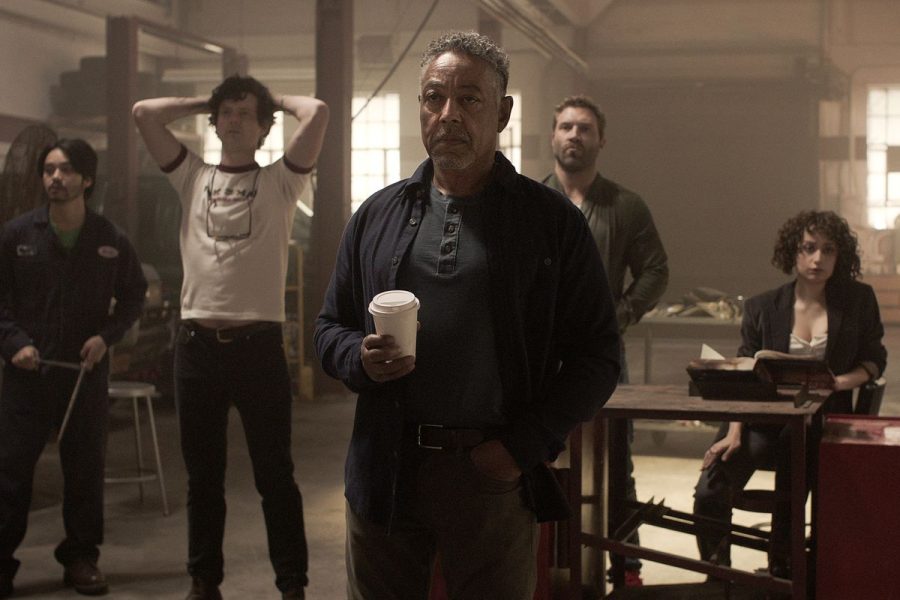Kaleidoscope: A Riveting Rainbow or Just a Flashy Flop?
Giancarlo Esposito stars as criminal mastermind Leo Pap in “Kaleidoscope,” Netflix’s latest series that features a unique twist: the episodes can be watched in any order. Though Esposito has received praise for yet another incredible performance, the series itself has been slammed with mixed reviews.
Netflix’s latest show, “Kaleidoscope” is making waves, or should we say, light waves online. Starring big name actors like Giancarlo Esposito, known for his role as the fried-chicken kingpin Gustavo Fring in “Breaking Bad,” the heist-thriller features a unique twist: the episodes aren’t numbered, so viewers are meant to watch the show in any order they please.
This isn’t the first time Netflix has revolutionized the viewing experience. In 2018, Netflix realized “Bandersnatch,” an interactive film that allowed viewers to make choices that influenced how the story progressed and eventually ended. “Bandersnatch” had five unique endings and a plethora of different choices to make throughout, therefore, one version of “Bandersnatch” a viewer watched had potential to be a completely different film than another version.
The difference between “Kaleidoscope” and “Bandersnatch” are that unlike the latter, each viewer that watches “Kaleidoscope” will see all the same scenes, the only difference is the order.
The story follows a crew of criminals and their attempt at breaking into the world’s most secure vault, the biggest heist in history. The events are loosely based on an unsolved 2012 case in which $70 billion worth of bonds went missing in Manhattan during Hurricane Sandy. The show consists of 8 episodes, each titled a different color: “Yellow,” “Green,” “Violet,” “Blue,” “Orange,” “Red,” “Pink,” and “White.” Different episodes portray different stages in the heist, the preparation, execution, and aftermath. There are 40,320 unique orders the show may be watched in, and has sparked much debate online regarding the “correct” order. If a viewer wants to watch the show in chronological order, the episodes would be, “Violet,” “Green,” “Yellow,” “Orange,” “Blue,” “White,” “Red,” and “Pink,” with “Violet” taking place 24 years before the heist and “Pink,” 6 months after. Other viewers strongly believe that the order really doesn’t matter, as long as “White” comes last, since it’s the episode in which the heist actually takes place.
“Kaleidoscope” has been applauded for its bold new take on storytelling. “Stylish, suspenseful, and cleverly executed, ‘Kaleidoscope’ gathers binge-worthy momentum as it barrels towards its climactic shutdown,” raves Michael Hogan for The Telegraph.
However, while some critics praise “Kaleidoscope,” others remark that the episodes not being in a specific order weakens the plot. “A good heist story builds itself so that, in the end, you get a fantastic moment of catharsis as the heist occurs. ‘Kaleidoscope’ can’t really deliver this,” writes Matthew Razak for The Escapist Magazine. “Its random episode presentation means there’s no control over the pace or plotting, leaving each episode to do its own work instead of delivering a satisfying heist tale.” Louis Chilton for Insider describes “Kaleidoscope’s” non-linear storytelling as a “pointless gimmick” that is a “desperate attempt to stay fresh.” Other critics say the plot is boring and the characters are flat. Since the show is created to be watched in a nonlinear fashion, the characters are unable to change or develop from beginning to end, since the series has no “real” beginning or end. Additionally, episodes are unable to end on exciting cliffhangers or generate any real buildup. “Nothing about the show or its characters has even the ounce of the charm it would take to make following them through this Byzantine shuffle of episodes anything other than a drag,” writes Austen Goslin for Polygon. “There’s nothing fundamentally interesting about learning things in a random order.”
Is “Kaleidoscope” as equally riveting as it is revolutionary? Or is it a bland heist story with a splash of color? Find out for yourself! Here are some popular options for watching:
Chronologically:
Violet-24 years before the heist
Green-7 years before the heist
Yellow-6 weeks before the heist
Orange-3 weeks before the heist
Blue-5 days before the heist
White-The heist
Red-The morning after
Pink-6 months after the heist
The Rainbow, ending with the heist:
Red
Orange
Yellow
Green
Blue
Pink
Violet
White
Kaleidoscope: Directed by Quentin Tarantino
Blue
Green
Yellow
Orange
Violet
Pink
White
Red
Kaleidoscope: A Classic Detective Story
Orange
Green
Violet
Red
Yellow
Blue
White
Pink






















































Mr. B • Jan 27, 2023 at 9:52 AM
I also saw the mixed reviews which prevented me from giving it a long enough look. It’s a creative concept.